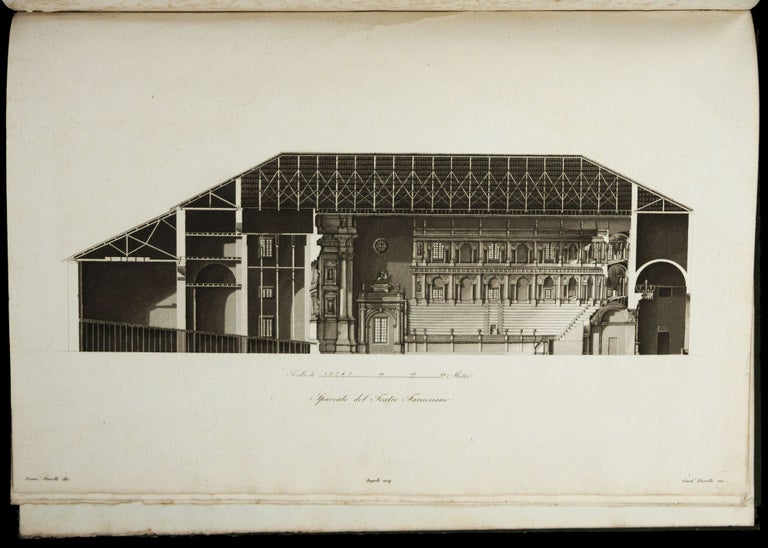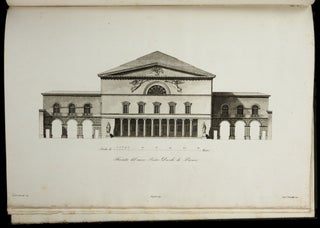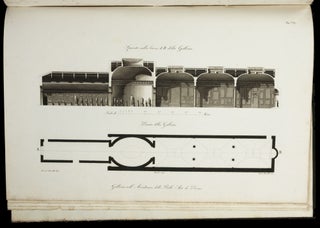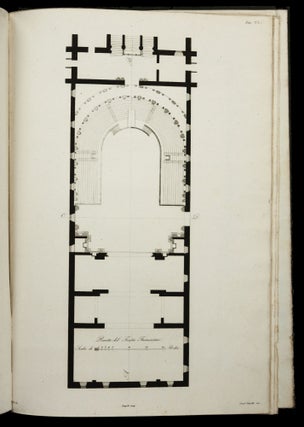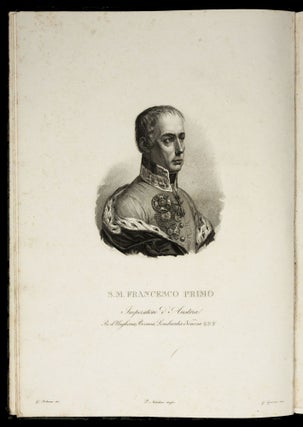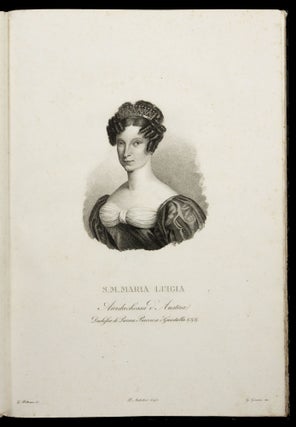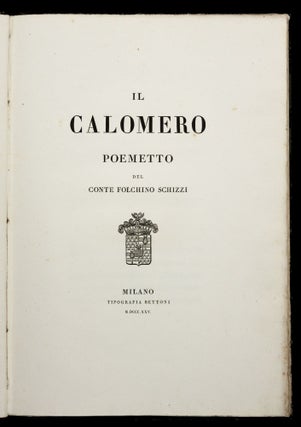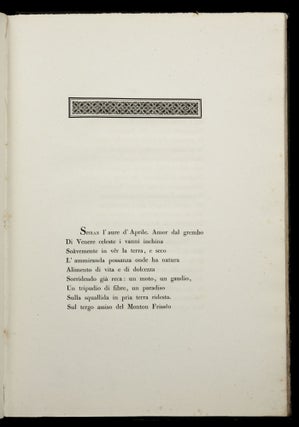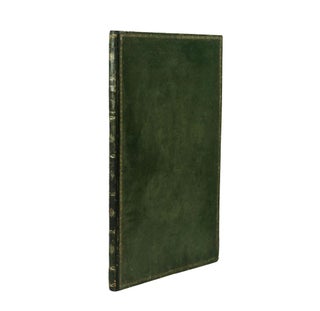Il Calomero. Poemetto.
Large 4to [39.1 x 27.4 cm], XXXV pp., (1) p., with (2) ff. full-page engraved portraits and (6) full-page architectural etching-and-aquatint plates numbered III-VIII, and with one additional plate numbered VII (from the second edition), volume numbered 27 of an edition of 200. Bound in contemporary green morocco, spine gold tooled and stamped with title, gold-tooled floral borders to upper and lower cover, tissue guards protecting plates. Minor rubbing and edge wear to spine and boards. Some quires still unopened, occasional minor edge toning, spotting to some of the tissue guards, the occasional minor unobtrusive stain, mend to blank margin of plate VII. Rare first edition of this unusual architectural-poetical work by the aristocratic belle-lettrist Conte Folchino Schizzi (1797-1857) celebrating the recent architectural patronage of Maria Luigia, Duchess of Parma (1791-1847), Napoleon Buonaparte’s (1769-1821) second wife. Of special note are treatments of Maria Luigia’s Teatro Regio di Parma (Nuovo Teatro Ducale), an opera house still under construction at the time of publication and whose design she is said to have monitored closely, and the famed Teatro Farnese in Parma, whose renovations and upkeep she financed. Schizzi adds to the poem (cryptically titled “Il Calomero”) a series of fine full-page aquatints illustrating the architectural projects alluded to in his verse. Lest readers miss these and other references, he also provides extensive footnotes identifying his allusions. Schizzi had just 200 numbered examples of this deluxe work printed, and he states explicitly that all copies were intended to be given as gifts, with none available for general sale. Il Calomero thus is both an interesting work devoted to an important female architectural patron in the early 19th century and an intriguing record of how such projects were praised and promoted among Italian literati at the time. The volume opens with full-page engraved portraits of Maria Luigia and Francis I of Austria (Francis II, Holy Roman Emperor; 1768-1835) and a short introduction addressing the citizens of Parma. The some 400-line “Il Calomero” is a neoclassical poem of exalted register that interweaves metaphors of Olympian gods, allusions to Maria Luigia’s life and patronage, and other learned references (e.g., the typography of Giambattista Bodoni [1740-1813], the poetry of Erasmus Darwin [1731-1803], the writings of the Parma Hebraist Giovanni Bernardo De Rossi [1742-1831], etc.). In the poem Schizzi mentions two bridges built by Maria Luigia – the Ponte sul Taro and the Ponte sulla Trebbia –, and these are illustrated in plan, elevation and section in aquatints by Gaetano Durelli made after designs by Francesco Durelli. Also depicted is the (distinctive) neoclassical façade of Maria Luigia’s 1400-seat Nuovo Teatro Ducale, a house whose importance to Italian opera in the 19th century would come to rival La Scala in Milan and La Fenice in Venice. Three plates are devoted to the famed Teatro Farnese, built by Giovanni Battista Aleotti (1546-1636) in 1618 and long under the protection of the Dukes (and Duchesses) of Parma, and thus of primary importance to Maria Luigia. The Teatro Farnese is shown in plan and in lateral section, and the proscenium – the first permanent proscenium in the history of theater architecture – is also depicted. Schizzi also mentions the Accademia di Belle Arti di Parma, which Maria Luigia revived after a period of suppression following the Napoleonic occupation of 1803-14. A depiction of the Gallery of the Accademia (plan and lateral section) did not appear in Il Calomero until the 1827 second edition, but intriguingly that plate (VII) does appear in the present volume, apparently having been bound in by the original owner eager to fill out his first edition with the only new plate added in the second edition. We have found no other examples of a first edition augmented with this additional plate. The poem’s unusual title puzzled many readers, but several contemporary reviews addressed this mystery: “The fantastic title which Count Schizzi has given to his poem requires some explanation. It signifies Buonaparte; the Greek word Καλόμερος [Calomeros], having the same name which Napoleon’s family name bears in Italian. There exists a tradition, according to which the Buonaparte family originally came from Maina, a mountainous region on the Peloponnesus. On their emigration to Corsica, about the end of the 17th century, their name was translated from Καλόμερος to Buonaparte. The censorship of Milan did not, perhaps, understand the meaning of ‘Calomero,’ otherwise it is not likely that the work would have made its appearance under that obnoxious title” (“Miscellaneous Intelligence…,” p. 258). Being both the former wife of Napoleon (and thus Empress of the French) during the Duchy of Parma’s occupation by French troops and the current Duchess of Parma, Maria Luigia held an unusual (and uneasy) position between past and present regimes. It is likely that Schizzi, in his title, was only playing a literary game by alluding to her Napoleonic past but it seems that censors were in fact alerted, because the word ‘Calomero’ appears nowhere in the 1827 second edition of this work, which was retitled Un bel giorno. OCLC locates U.S. examples of Il Calomero at the Getty, Cornell, the Morgan Library, the Eastman School of Music, Johns Hopkins, and Wayne State. The 1827 second edition (Un bel giorno) is housed at the Morgan Library, Harvard, and Princeton. * “Miscellaneous Intelligence Relative to Literature and the Arts in Italy,” The Oriental Herald and Journal of General Literature, vol. 15, no. 47, p. 258; “Il conte Folchino Schizzi” (obit), in Atti dell’ Accademia Fisio-Medico-Statistica di Milano, Anno accademico 1856-1857, new series, vol. 2, p. 227-9; Biblioteca italiana ossia giornale di letteratura scienze ed arti, vol. XLI (1826), pp. 72-3; “Literary and Miscellaneous Intelligence, Domestic and Foreign,” The Monthly Review, vol. V (1827), p. 470.
Price: $5,500.00

